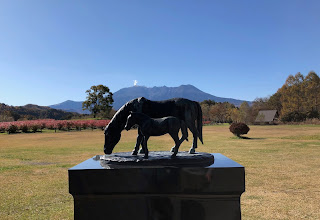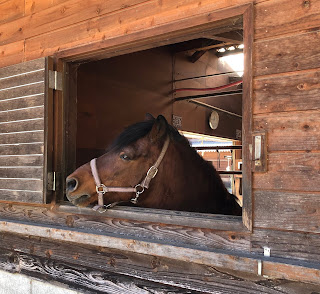One of the highlights of last November's 130-km hike along the Nakasendo was an overnight detour along the Hida Kaido, an even older route once used to transport salt and horses over the Jizō pass to and from the Kaida Plateau.
 |
| Kisouma no Sato, on the Kaida Plateau, home of the Kiso Horse |
The Kaida Plateau was once the primary breeding ground for the short, stocky Kiso horses (kisouma) that were favored both as samurai mounts and as beasts of burden on the travel roads. Kiso horses average 133cm at the withers, and are generally dun or brown in color.
 |
| A friendly Kiso horse |
They are native to Japan, and were long considered a food source, as well as working animals, in the Kaida area. In fact, basashi, horsemeat sashimi, is still a regional specialty of Kaida.
 |
| Welcome to Kiso. Make new friends . . . and eat them. |
(And despite the cognitive dissonance it creates in my horse-loving heart, I think it's delicious.)
My hike to and through the Kaida Plateau included a stop at Kisouma no Sato, the "Kiso Horse Village" where these now-endangered horses are preserved, celebrated, and bred.
 |
| A resident of Kiso Horse Village |
(For riding and interacting with, not for eating.)
The horses live in stables and large, open paddocks, with plenty of room to graze and exercise.
 |
| Horses grazing on the Kaida Plateau |
Smaller paddocks near the walking paths offer visitors the opportunity to touch and interact with the horses one-on-one, while larger grazing areas give an idea of the way the horses were formerly allowed to roam the open areas of the Kaida plateau.
 |
| One on one time with the Kiso horses |
Kisouma no Sato also has a visitor center with information and educational films about the history of the Kiso horse, and its importance to the region and to Japan.
Sadly, I didn't have time to take advantage of the opportunity to ride (visitors can either saddle up or ride in a horse-drawn cart) but I have plans to return.
 |
| So long, but not goodbye. |
I'm sure my little fuzzy buddy will be waiting.















I do wonder where the world would be if the horse hadn't evolved. And in particular those strong hardy fuzzy little horses that small communities relied on: a cross between a SUV, a combine harvester and a fertiliser bag
ReplyDeleteJust another fascinating post about a culture I'd never know about in such depth without you. It brought back memories of a post years back by Yrsa on Iceland ponies, and a smile to my face at how correct Caro's observation on where we'd be without the horse. Imagine Roy Rogers or Gene Autry on the back of a donkey. Nah, they were both Republicans. :)
ReplyDelete